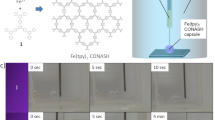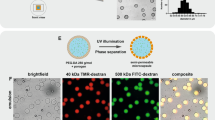Abstract
Many smart materials in bioengineering, nanotechnology and medicine allow the storage and release of encapsulated drugs on demand at a specific location by an external stimulus. Owing to their versatility in material selection, polyelectrolyte multilayers are very promising systems in the development of microencapsulation technologies with permeation control1,2,3,4 governed by variations in the environmental conditions5,6,7,8. Here, organometallic polyelectrolyte multilayer capsules, composed of polyanions and polycations of poly(ferrocenylsilane) (PFS), are introduced. Their preparation involved layer-by-layer self-assembly onto colloidal templates followed by core removal. PFS polyelectrolytes feature redox-active ferrocene units in the main chain. Incorporation of PFS into the capsule walls allowed us to explore the effects of a new stimulus, that is, changing the redox state9,10, on capsule wall permeability. The permeability of these capsules could be sensitively tuned via chemical oxidation, resulting in a fast capsule expansion accompanied by a drastic permeability increase in response to a very small trigger. The substantial swelling could be suppressed by the application of an additional coating bearing common redox-inert species of poly(styrene sulfonate) (PSS−) and poly(allylamine hydrochloride) (PAH+) on the outer wall of the capsules. Hence, we obtained a unique capsule system with redox-controlled permeability and swellability with a high application potential in materials as well as in bioscience.
This is a preview of subscription content, access via your institution
Access options
Subscribe to this journal
Receive 12 print issues and online access
$259.00 per year
only $21.58 per issue
Buy this article
- Purchase on SpringerLink
- Instant access to full article PDF
Prices may be subject to local taxes which are calculated during checkout




Similar content being viewed by others
References
Dähne, L., Leporatti, S., Donath, E. & Möhwald, H. Fabrication of micro reaction cages with tailored properties. J. Am. Chem. Soc. 123, 5431–5436 (2001).
Lvov, Y., Antipov, A. A., Mamedov, A., Möhwald, H. & Sukhorukov, G. B. Urease encapsulation in nanoorganized microshells. Nano Lett. 1, 125–128 (2001).
Gao, C., Donath, E., Möhwald, H. & Shen, J. Spontaneous deposition of water-soluble substances into microcapsules: phenomenon, mechanism, and application. Angew. Chem. Int. Edn 41, 3789–3793 (2002).
Ibarz, G., Dähne, L., Donath, E. & Möhwald, H. Smart micro- and nanocontainers for storage, transport, and release. Adv. Mater. 13, 1324–1327 (2001).
Sukhorukov, G. B., Antipov, A. A., Voigt, A., Donath, E. & Möhwald, H. pH-controlled macromolecule encapsulation in and release from polyelectrolyte multilayer nanocapsules. Macromol. Rapid Commun. 22, 44–46 (2001).
Antipov, A. A., Sukhorukov, G. B. & Möhwald, H. Influence of the ionic strength on the polyelectrolyte multilayers’ permeability. Langmuir 19, 2444–2448 (2003).
Glinel, K., Sukhorukov, G. B., Möhwald, H., Khrenov, V. & Tauer, K. Thermalsensitive hollow capsules based on thermoresponsive polyelectrolytes. Macromol. Chem. Phys. 204, 1784–1790 (2003).
Radt, B., Smith, T. A. & Caruso, F. Optically addressable nanostructured capsules. Adv. Mater. 16, 2184–2189 (2004).
Zou, S., Hempenius, M. A., Schönherr, H. & Vancso, G. J. Force spectroscopy of individual stimulus-responsive poly(ferrocenyldimethylsilane) chains: towards a redox-driven macromolecular motor. Macromol. Rapid Commun. 27, 103–108 (2006).
Zou, S., Korczagin, I., Hempenius, M. A., Schönherr, H. & Vancso, G. J. Single molecule force spectroscopy of smart poly(ferrocenylsilane) macromolecules: towards highly controlled redox-driven single chain motors. Polymer 47, 2483–2492 (2006).
Kwon, I. C., Bae, Y. H. & Kim, S. W. Electrically credible polymer gel for controlled release of drugs. Nature 354, 291–293 (1991).
Yerushalmi, R., Scherz, A., van der Boom, M. E. & Kraatz, H.-B. Stimuli responsive materials: new avenues toward smart organic devices. J. Mater. Chem. 15, 4480–4487 (2005).
Pudelski, J. K. et al. Synthesis, characterization, and properties of high molecular weight poly(methylated ferrocenylsilanes) and their charge transfer polymer salts with tetracyanoethylene. Macromolecules 29, 1894–1903 (1996).
Nguyen, M. T., Diaz, A. F., Dement’ev, V. V. & Pannell, K. H. High molecular weight poly(ferrocenediyl-silanes): synthesis and electrochemistry of [− (C5H4)Fe(C5H4)SiR2−]n, R=Me, Et, n-Bu, n-Hex. Chem. Mater. 5, 1389–1394 (1993).
Arsenault, A. C., Miguez, H., Kitaev, V., Ozin, G. A. & Manners, I. A polychromic, fast response metallopolymer gel photonic crystal with solvent and redox tunability: a step towards Photonic Ink (P-Ink). Adv. Mater. 15, 503–507 (2003).
Rulkens, R. et al. Linear oligo(ferrocenyldimethylsilanes) with between two and nine ferrocene units: electrochemical and structural models for poly(ferrocenylsilane) high polymers. J. Am. Chem. Soc. 118, 12683–12695 (1996).
Péter, M. et al. Electrochemically induced morphology and volume changes in surface-grafted poly(ferrocenyldimethylsilane) monolayers. Langmuir 20, 891–897 (2004).
Shi, W. et al. Single-chain elasticity of poly(ferrocenyldimethylsilane) and poly(ferrocenylmethylphenylsilane). Macromolecules 37, 1839–1842 (2004).
Hempenius, M. A., Robins, N. S., Péter, M., Kooij, E. S. & Vancso, G. J. Water-soluble poly(ferrocenylsilanes) for supramolecular assemblies by layer-by-layer deposition. Langmuir 18, 7629–7634 (2002).
Hempenius, M. A. & Vancso, G. J. Synthesis of polyanionic water-soluble poly(ferrocenylsilane). Macromolecules 35, 2445–2447 (2002).
Hempenius, M. A., Brito, F. F. & Vancso, G. J. Synthesis and characterization of anionic and cationic poly(ferrocenylsilane) polyelectrolytes. Macromolecules 36, 6683–6688 (2003).
Ginzburg, M. et al. Layer-by-layer self-assembly of organic-organometallic polymer electrostatic superlattices using poly(ferrocenylsilanes). Langmuir 16, 9609–9614 (2000).
Decher, G. Fuzzy nanoassemblies: toward layered polymeric multicomposites. Science 277, 1232–1237 (1997).
Donath, E., Sukhorukov, G. B., Caruso, F., Davis, S. A. & Möhwald, H. Novel hollow polymer shells by colloid-templated assembly of polyelectrolytes. Angew. Chem. Int. Edn 37, 2201–2205 (1998).
Caruso, F., Lichtenfeld, H., Donath, E. & Möhwald, H. Investigation of electrostatic interactions in polyelectrolyte multilayer films: binding of anionic fluorescent probes to layers assembled onto colloids. Macromolecules 32, 2317–2328 (1999).
Antipov, A. A. et al. Carbonate microparticles for hollow polyelectrolyte capsules fabrication. Colloids Surf. A 224, 175–183 (2003).
Zhu, H., Stein, E. W., Lu, Z., Lvov, Y. M. & McShane, M. J. Synthesis of size-controlled monodisperse manganese carbonate microparticles as templates for uniform polyelectrolyte microcapsule formation. Chem. Mater. 17, 2323–2328 (2005).
Zhang, H. & Rühe, J. Polyelectrolyte multilayers on weak polyelectrolyte brushes. Macromol. Rapid Commun. 24, 576–579 (2003).
Giannotti, M. I. et al. Stimulus responsive poly(ferrocenylsilanes): redox chemistry of iron in the main chain. J. Inorg. Organom. Polym. Mater. 15, 527–540 (2005).
Acknowledgements
The authors are grateful to E. S. Kooij (University of Twente) for his help with the ellipsometry measurements on planar multilayer films and to A. Heilig for her help with the AFM measurements in the Max Planck Institute of Colloids and Interfaces, Golm. The University of Twente, the MESA+ Institute for Nanotechnology of the University of Twente, the Dutch Science Foundation for Chemical Research NWO-CW and NanoImpuls, a Nanotechnology Program of the Ministry of Economic Affairs of the Netherlands, are acknowledged for financial support.
Author information
Authors and Affiliations
Corresponding author
Ethics declarations
Competing interests
The authors declare no competing financial interests.
Supplementary information
Supplementary Information
Supplementary figures S1, S2 and S3 (PDF 105 kb)
Rights and permissions
About this article
Cite this article
Ma, Y., Dong, WF., Hempenius, M. et al. Redox-controlled molecular permeability of composite-wall microcapsules. Nature Mater 5, 724–729 (2006). https://doi.org/10.1038/nmat1716
Received:
Accepted:
Published:
Issue Date:
DOI: https://doi.org/10.1038/nmat1716
This article is cited by
-
Polyelectrolytes of Inorganic Polyoxometalates: Prospecting New Charged Polymers for Advanced Applications
Chinese Journal of Polymer Science (2024)
-
Ferrocene-Modified Metal–Organic Frameworks as a Peroxidase-Mimicking Catalyst
Catalysis Letters (2021)
-
Design and Construction of Bioreactor Based on Hybrid Microcapsules and its Bio-catalytic Performance
Journal of Inorganic and Organometallic Polymers and Materials (2021)
-
Microcapsules responsive to pH and temperature: synthesis, encapsulation and release study
SN Applied Sciences (2019)
-
Metallo-polyelectrolytes as a class of ionic macromolecules for functional materials
Nature Communications (2018)



